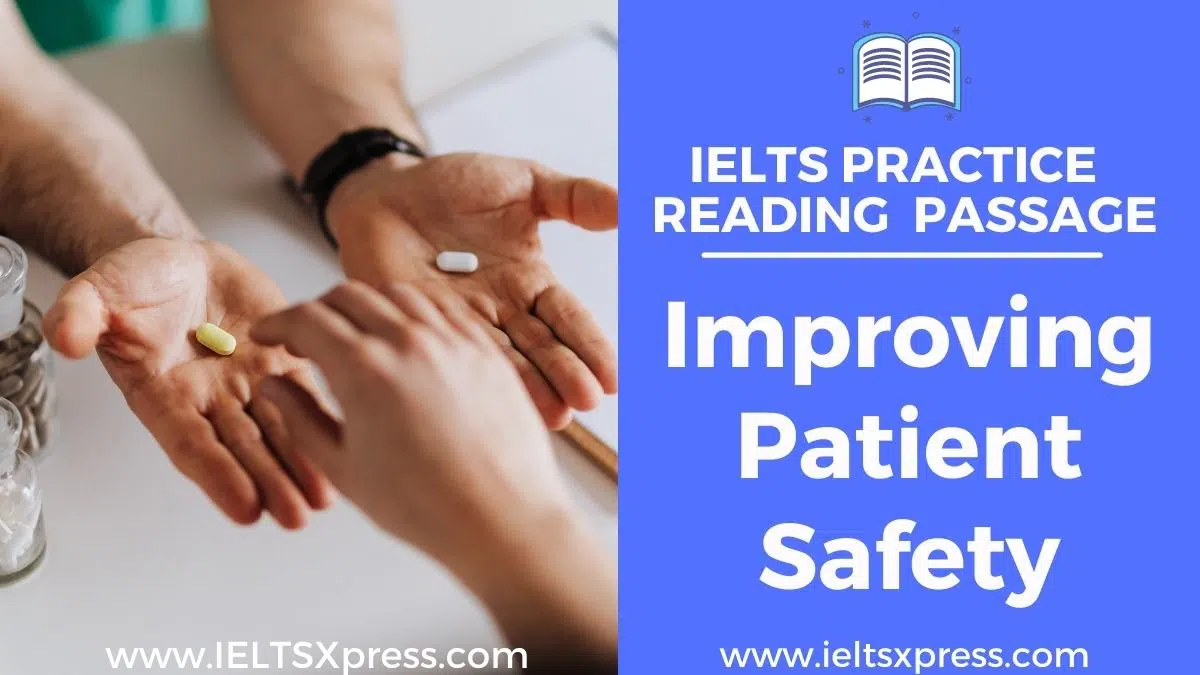Improving Patient Safety IELTS Reading Passage with Answers
Reading Passage 3
You should spend about 20 minutes on Questions 27-40 which are based on Reading Passage 3 below.
Improving Patient Safety
Packaging
One of the most prominent design issues in pharmacy is that of drag packaging and patient information leaflets (Pits). Many letters have appeared in The Journal’s letters pages over the years from pharmacists dismayed at the designs of packaging that are “accidents waiting to happen”.
Packaging design in the pharmaceutical industry is handled by either in-house teams or design agencies. Designs for over-the-counter medicines, where characteristics such as attractiveness and distinguish-ability are regarded as significant, are usually commissioned from design agencies. A marketing team will prepare a brief and the designers will come up with perhaps six or seven designs. These are whittled down to two or three that might be tested on a consumer group. In contrast, most designs for prescription-only products are created in-house. In some cases, this may simply involve applying a company’s house design (ie, logo, colour, font, etc). The chosen design is then handed over to design engineers who work out how the packaging will be produced.
Design considerations
The author of the recently published “Information design for patient safety,” Thea Swayne, tracked the journey of a medicine from manufacturing plant, through distribution warehouses, pharmacies and hospital wards, to patients’ homes. Her book highlights a multitude of design problems with current packaging, such as look-alikes and sound-alikes, small type sizes and glare on blister foils. Situations in which medicines are used include a parent giving a cough medicine to a child in the middle of the night and a busy pharmacist selecting one box from hundreds. It is argued that packaging should be designed for moments such as these. “Manufacturers are not aware of the complex situations into which products go. As designers, we are interested in not what is supposed to happen in hospital wards, but what happens in the real world,” Ms Swayne said.
Incidents where vein has been injected intrathecally instead of spine are a classic example of how poor design can contribute to harm. Investigations following these tragedies have attributed some blame to poor typescript.
Safety and compliance
Child protection is another area that gives designers opportunities to improve safety. According to the Child Accident Prevention Trust, seven out of 10 children admitted to hospital with suspected poisoning have swallowed medicines. Although child-resistant closures have reduced the number of incidents, they are not: fully child-proof. The definition of such a closure is one that not more than 15 percent of children aged between 42 and 51 months can open within five minutes. There is scope for improving what is currently available, according to Richard Mawle, a freelance product designer. “Many child-resistant packs
are based on strength. They do not necessarily prevent a child from access, but may prevent people with a disability,” he told The Journal. “The legal requirements are there for a good reason, but they are not good enough in terms of the users,” he said. “Older people, especially those with arthritis, may have the same level of strength as a child,” he explained, and suggested that better designs could rely on cognitive skills (eg, making the opening of a container a three-step process) or be based on the physical size of hands.
Mr. Mawle worked with GlaxoSmithKline on a project to improve compliance through design, which involved applying his skills to packaging and PILs. Commenting on the information presented, he said: “There can be an awful lot of junk at the beginning of PILs. For example, why are company details listed towards the beginning of a leaflet when what might be more important for the patient is that the medicine should not be taken with alcohol?”
Design principles and guidelines
Look-alike boxes present a potential for picking errors and an obvious solution would be to use colours to highlight different strengths. However, according to Ms.Swayne, colour differentiation needs to be approached with care. Not only should strong colour contrasts be used, but designating a colour to a particular strength (colour coding) is not recommended because this could lead to the user not reading the text on a box.
Design features can provide the basis for lengthy debates. For example, one argument is that if all packaging is white with black lettering, people would have no choice but to read every box carefully. The problem is that trials of drug packaging design are few—common studies of legibility and comprehensibility concern road traffic signs and visual display units. Although some designers take results from such studies into account, proving that a particular feature is beneficial can be difficult. For example, EU legislation requires that packaging must now include the name of the medicine in Braille but, according to Karel van der Waarde, a design consultant to the pharmaceutical industry, “it is not known how much visually impaired patients will benefit nor how much the reading of visually able patients will be impaired”.
More evidence might, however, soon be available. EU legislation requires PILs to reflect consultations with target patient groups to ensure they are legible, clear and easy to use. This implies that industry will have to start conducting tests. Dr. van der Waarde has performed readability studies on boxes and PILs for industry. A typical study involves showing a leaflet or package to a small group and asking them questions to test understanding. Results and comments are used to modify the material, which is then tested on a larger group. A third group is used to show that any further changes made are an improvement. Dr. van der Waarde is, however, sceptical about the legal requirements and says that many regulatory authorities do not have the resources to handle packaging information properly. “They do not look at the use of packaging in a practical context—they only see one box at a time and not several together as pharmacists would do,” he said.
Innovations
The RCA innovation exhibition this year revealed designs for a number of innovative objects. “The popper”, by Hugo Glover, aims to help arthritis sufferers remove tablets from blister packs, and “pluspoint”, by James Cobb, is an adrenaline auto-injector that aims to overcome the fact that many patients do not carry their auto-injectors due to their prohibitive size. The aim of good design, according Roger Coleman, professor of inclusive design at the RCA, is to try to make things more user-friendly as well as safer. Surely, in a patient-centred health system, that can only be a good thing. “Information design for patient safety” is not intended to be mandatory. Rather, its purpose is to create a basic design standard and to stimulate innovation. The challenge for the pharmaceutical industry, as a whole, is to adopt such a standard.
Questions 27-32
Look at the following statements (Questions 27-32) and the list of people or organisation below.
Match each statement with the correct person or organisation, A-D.
Write the correct letter, A-D, in boxes 27-32 on your answer sheet.
NB You may use any letter more than once.
A Thea Swayne
B Children Accident Prevention Trust
C Richard Mawle
D Karel van der Waarde
27 Elderly people may have the same problem with children if the lids of containers require too much strength to open.
28 Adapting packaging for the blind may disadvantage the sighted people.
29 Specially designed lids cannot eliminate the possibility of children swallowing pills accidentally.
30 Container design should consider situations, such as drug used at home.
31 Governing bodies should investigate many different container cases rather than individual ones.
32 Information on the list of a leaflet hasn’t been in the right order.
Questions 33-37
Complete the notes using the list of words, A-G, below.
Write the correct letter, A-G, in boxes 33-37 on your answer sheet.
Packaging in Pharmaceutical Industry
Designs for over-the-counter medicines
First, 33______ make the proposal, then pass them to the 34______ Finally, these designs will be tested by 35_____
Prescription-only
First, the design is made by 36______ and then subjected to 37_____
A consumers
B marketing teams
C pharmaceutical industry
D external designers
E in-house designers
F design engineers
G pharmacist
Questions 38-40
Choose the correct letter, A, B, C or D.
Write the correct letter in boxes 38-40 on your answer sheet.
38 What may cause the accident in “design container”?
A a print error
B style of print
C wrong label
D the shape of the bottle
39 What do people think about the black and white only print?
A Consumers dislike these products.
B People have to pay more attention to the information.
C That makes all products looks alike.
D Sighted people may feel it more helpful.
40 Why does the writer mention “popper” and “pluspoint”?
A to show that container design has made some progress
B to illustrate an example of inappropriate design which can lead to accidents
C to show that the industry still needs more to improve
D to point out that consumers should be more informed about the information
Improving Patient Safety IELTS Reading Passage Answers
Practice with Expert IELTS Tutors Online
Apply Code "IELTSXPRESS20" To Get 20% off on IELTS Mock Test
27. C
28. D
29. B
30. A
31. D
32. C
33. B
34. D
35. A
36. E
37. F
38. B
39. B
40. A
Also Check: What do Babies Know IELTS Reading Passage



